|
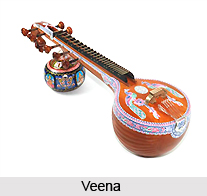 Origin of Veena can be traced back a long way into ancient history. Veena is a most popular string instrument used in Tamil Nadu South India. In fact it is the oldest musical instrument mentioned in literature. There has been much discussion and disagreement over the instrument called Veena in the Vedic writings (1500-500 B.C.). Loosely translated, the Veena means lute, and the ancient Veena apparently was similar to the instruments used in the ancient Egyptian and Middle Eastern civilizations. It is widely believed that it had a hollow belly covered with a board or stretched leather. The belly was broader towards the back where its end is rounded and tapers toward the front, and it is continued into an upstanding curved arm. The strings are stretched one above the other, from this arm to the belly. These strings vary in their length. This kind of Veena is found, although with minor variations, in the sculptures of the temples at Sanchi, Bhaja, and Bharhut (second to first century B.C.), at Amaravati (first to second century A.D.), at Nagarjunkonda (second to fourth century A.D.), and at other places. It is depicted as being placed on the lap and played either with the fingers or with a plectrum. Origin of Veena can be traced back a long way into ancient history. Veena is a most popular string instrument used in Tamil Nadu South India. In fact it is the oldest musical instrument mentioned in literature. There has been much discussion and disagreement over the instrument called Veena in the Vedic writings (1500-500 B.C.). Loosely translated, the Veena means lute, and the ancient Veena apparently was similar to the instruments used in the ancient Egyptian and Middle Eastern civilizations. It is widely believed that it had a hollow belly covered with a board or stretched leather. The belly was broader towards the back where its end is rounded and tapers toward the front, and it is continued into an upstanding curved arm. The strings are stretched one above the other, from this arm to the belly. These strings vary in their length. This kind of Veena is found, although with minor variations, in the sculptures of the temples at Sanchi, Bhaja, and Bharhut (second to first century B.C.), at Amaravati (first to second century A.D.), at Nagarjunkonda (second to fourth century A.D.), and at other places. It is depicted as being placed on the lap and played either with the fingers or with a plectrum.
Some Indian scholars hold that the lute-type Veenas (with a body and a neck) are found as early as the Amaravati and Nagarjunkonda sculptures of the first or second century A.D.Zither-type Veenas (with strings stretching along the entire length of the body) first appear in the Mahabalipuram reliefs of the sixth and seventh centuries A.D., as well as in the paintings of the Ajanta caves (seventh century A.D.) and Ellora caves (eighth to eleventh century A.D.). All of these types of Veenas lacked the frets that are now found on the South Indian Veenas. One of the earliest zither-type Veenas consisted of a long pole called chanda, along which the strings were stretched. Resonance seems to have been provided by partial gourds or hollowed-out gourds, or wooden globes, one towards either end of the danda and attached to its underside.
The ways and means in which the ancient Veena must have been played are open to discussion. Bhasa, a dramatist who flourished sometime in the 5th century AD, mentioned in a play that the Veena was played with the fingernails. According to a modern author, the term Veena as mentioned in the Natyashastra, included all instruments that could be bowed and instruments that were plucked with the fingernails of one hand. Yet another modern author cites the Natyashastra as saying that one type of Veena was played with a plectrum and another type with the fingernails.
Thus, since such diverse sources such as classical literature and Sanskrit treatises mention so many different types of Veena, we can only conclude that the term Veena was a generic one. In all probability, it included instruments which had somewhat different shapes and sizes, different number of strings and different ways of being played. Judging by the different graphic and literary sources, it would seem that the Veena with frets came into vogue sometime in between the tenth and eleventh centuries A.D.
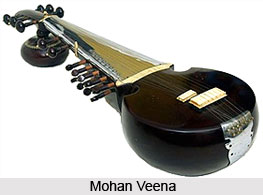 Veena is a classical Hindu lute belonging to the family of string musical instruments. It is an ancient musical instrument which is said to have been invented by Narada, one of the seven great rishis, who was also a Veena maestro. Veena is a plucked string instrument, about four feet long, carved and with a hollowed structure made of wood generally jack wood. Veena is considered to be an aristocrat among instruments. Good quality Veenas are carved from a single block of wood, whereas, ordinary Veenas are divided into three sections namely resonator, neck and head. Its tapered hollow neck contains metal frets set into wax on wooden tracks. One more resonator is present on the top of the long neck of Veena. This is used as a stand to position the instrument. Usually it has seven strings, made up of steel along with a long finger board containing 19 to 21 frets or supports. According to the number of strings there are several variations of the Veena. The performer has to place one gourd on the shoulder and the other one on the hip. Depending on the construction and melody, Veena can be categorized into several types. Veena is a classical Hindu lute belonging to the family of string musical instruments. It is an ancient musical instrument which is said to have been invented by Narada, one of the seven great rishis, who was also a Veena maestro. Veena is a plucked string instrument, about four feet long, carved and with a hollowed structure made of wood generally jack wood. Veena is considered to be an aristocrat among instruments. Good quality Veenas are carved from a single block of wood, whereas, ordinary Veenas are divided into three sections namely resonator, neck and head. Its tapered hollow neck contains metal frets set into wax on wooden tracks. One more resonator is present on the top of the long neck of Veena. This is used as a stand to position the instrument. Usually it has seven strings, made up of steel along with a long finger board containing 19 to 21 frets or supports. According to the number of strings there are several variations of the Veena. The performer has to place one gourd on the shoulder and the other one on the hip. Depending on the construction and melody, Veena can be categorized into several types.
Rudra Veena
There are several variations of the Veena and its designs have been evolved over the years. In the field of North Indian Classical Music the bin, also known as Rudra Veena, is most commonly used. It consists of a stem, about three feet long, that supports a bamboo fret board approximately twenty-two inches long and two and a half inches wide. It has twenty-four metal frets, which are set to the half-steps in two octaves. 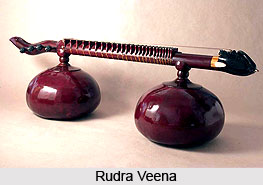 The frets are stationary, fixed in a resinous substance. The two resonating gourds are large, about fourteen inches in diameter. It has four main playing strings, which are tuned to Ma, Sa, Pa, and re. This gives the instrument a total range of over three octaves. Most of the melody, however, is produced on the first string, which is closest to the player's body. Three additional strings, which are suspended on the sides and not over the frets, are tuned to SA, SA and SA. These are drone and rhythm strings. The index and middle fingers of the right hand are used for plucking the melody strings; the little finger plays the drone. The index and middle fingers and occasionally the ring finger of the left hand reach around from under the stem to stop the strings. The plectrum used for the bin is like that of the sitar, but is worn sideways on the finger. Some Veena players use their fingernail rather than a plectrum for plucking. The performer sits cross-legged and holds the instrument at a slant to the left shoulder, the upper gourd resting on the shoulder and the lower gourd on the right knee. The frets are stationary, fixed in a resinous substance. The two resonating gourds are large, about fourteen inches in diameter. It has four main playing strings, which are tuned to Ma, Sa, Pa, and re. This gives the instrument a total range of over three octaves. Most of the melody, however, is produced on the first string, which is closest to the player's body. Three additional strings, which are suspended on the sides and not over the frets, are tuned to SA, SA and SA. These are drone and rhythm strings. The index and middle fingers of the right hand are used for plucking the melody strings; the little finger plays the drone. The index and middle fingers and occasionally the ring finger of the left hand reach around from under the stem to stop the strings. The plectrum used for the bin is like that of the sitar, but is worn sideways on the finger. Some Veena players use their fingernail rather than a plectrum for plucking. The performer sits cross-legged and holds the instrument at a slant to the left shoulder, the upper gourd resting on the shoulder and the lower gourd on the right knee.
Sarasvati Veena
The modern Veena used in Carnatic music is quite different in construction from the northern Veena. The most noticeable difference inSarasvati Veena is the repositioning of one of the gourds of Veena, so that the stem runs into it. This Veena is therefore a lute-type instrument rather than a zither, since its stem becomes a neck. Its gourd is not actually a gourd any longer; it is a hollowed-out chunk of wood, usually jackfruit that is closed in by a flat piece of wood. At the opposite end of the stem is attached a scroll, which is usually carved into the head of a dragon. Sarasvati Veena is said to be the abode of divinity as the Veena Danda represents Lord Shiva, the stringsParvati, the dragon head of Lord Vishnu, the bridge Goddess Lakshmi, the balancing gourd Lord Brahma and the connecting metal cone Sarasvati.
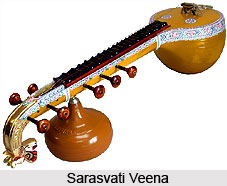
Gottuvadhyam
This musical instrument is also known as the Gottuvadyam, Chitra Veena or Mahanataka Veena and it is a Carnatic music string instrument. It is played mainly in south India and it is usually also used as a solo instrument in Carnatic music. This instrument resembles the Sarasvati Veena in its general form, but in many ways it is unique. The name Gottuvadhyam literally means 'block instrument'. It is a complicated ancient instrument with twenty-one strings, out of which there are six main strings used for melody that pass over the top of the instrument, three drone strings and about twelve sympathetic strings that run parallel and below the main strings.
Vichitra Veena
This is a plucked string instrument used in Hindustani music and it is a comparatively recent addition to the Veena family. It is similar to the Gottuvadhyam Veena, since it has no frets and is played with a slide. Vichitra Veena is made of a broad, fretless, horizontal arm or crossbar (dand) around three feet long and six inches wide, with two large resonating gourds (tumba), which are inlaid with ivory and attached underneath at either end. The narrow ends of the instrument are fashioned into peacock heads. This Veena has a five-octave range. There are four main playing strings and five secondary strings (chikaris), which are played openly with the little finger for a drone effect. Underneath them are 13 sympathetic strings tuned to the notes of the appropriate raaga.
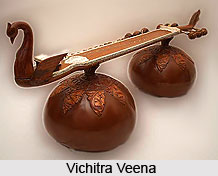
Mohan Veena
This is a stringed musical instrument used in Indian classical music and this was invented and popularized by Pandit Vishwa Mohan Bhatt. Though it comes in the category of classical instruments, it is not an ancient one, since it is actually a modified slide guitar with 20 strings: three melody strings, five drone strings strung to the peg head, and twelve sympathetic strings strung to the tuners mounted on the side of the neck. A tumba or gourd is screwed into the backside of the neck for improved sound quality and vibration. It is played by placing it on one's lap.
-Tamilan
|
|
|
|
|
|
No comments:
Post a Comment